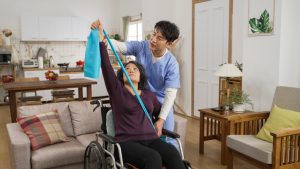What is the Difference Between an Occupational Therapist Assistant and Physical Therapist Assistant?
Published - December 21, 2023

What Does an Occupational Therapist Assistant Do?
An occupational therapist assistant (OTA) helps people overcome physical, emotional, and cognitive challenges, empowering them to participate more fully in the activities of daily life we take for granted. Under the supervision of a licensed occupational therapist, they work one-on-one with clients in a broad range of clinical and home health settings.
Duties vary based on the employment setting and scope of practice limitations set by the state, but they typically include:
Patient Evaluation
OTAs assist occupational therapists in evaluating a client’s functional abilities. They assess concerns related to safety, activities of daily living (ADLs), and self-care through interviews, observations, and testing.
Developing Treatment Plans
Occupational therapist assistants gather the current and historical health data required to develop individualized treatment plans. You’ll help the occupational therapist establish priorities and goals for each client’s unique wellness needs.
Implementing Therapeutic Interventions
OTAs implement the therapeutic interventions outlined in treatment plans. Client-centered exercises include cognitive training exercises, functional mobility training, balance and coordination drills, or adaptive strategies that promote independence despite permanent physical or mental challenges.
Tracking Patient Progress
Occupational therapy is a dynamic process. Progress should be made at each session. OTAs monitor and document the client’s response to treatment, working with licensed occupational therapists to adjust goals and interventions.
Administrative Tasks
Paperwork is an ever-present part of the therapy process. OTAs assist with administrative duties, from scheduling sessions to ordering supplies.
Providing Emotional Support
Therapy is rigorous. OTAs offer clients emotional support during therapy, encouraging a constructive and optimistic attitude. You’ll motivate people to participate actively in their emotional well-being through self-awareness and self-care practices that contribute to a positive, forward-thinking mindset.
Patient Education
OTAs are critical in helping clients understand their treatment plans, explaining the rationale behind interventions, and how each contributes to rehabilitation. Information and motivation, in large part, determine future success.
What Does a Physical Therapist Assistant Do?
A Physical Therapist Assistant (PTA) helps people recover from injuries, illnesses, or surgeries that affect their ability to move.
Their responsibilities include:
Patient Assessment
PTAs help physical therapists assess patients through data gathering, observation, and testing. Functional assessments help identify impairments and potential treatment options.
Implementing Treatment Plans
Under guidance from a licensed physical therapist, PTAs implement treatment plans. Interventions may include therapeutic exercises, manual therapy, pain relief measures, and other interventions designed to improve strength, balance, flexibility, coordination, and endurance.
Patient Monitoring
PTAs regularly assess and record patients’ progress during therapy sessions, documenting challenges and improvements. This information helps the physical therapist make ongoing treatment decisions.
Conducting Therapeutic Exercises
PTAs guide patients through therapeutic exercises, ensuring that movements are performed safely. You may also provide manual and device-assisted therapy, such as massage, stretching, traction, and range-of-motion exercises to alleviate discomfort, promote circulation, and enhance joint mobility.
Pain Management
Physical therapy speeds recovery by addressing pain symptoms. PTAs assist with heat, cold, ultrasound, and electrical stimulation treatments that reduce inflammation and promote tissue healing.
Patient Education
PTAs educate patients on their conditions, treatment plans, and home exercise programs, providing instruction on proper body mechanics, injury-prevention strategies, and using assistive devices from crutches to canes.
What Is the Difference Between an Occupational Therapist Assistant and a Physical Therapist Assistant?
Occupational and physical therapist assistants provide rehabilitation services but with a different emphasis. Let’s compare and contrast these two vital roles.
Focus
Occupational therapy is holistic. OTAs promote independence in daily living by addressing a broad range of life skills, including emotional, cognitive, and psychosocial interventions.
Responsibilities may overlap, but PTAs focus primarily on improving physical function.
Training Requirements
PTAs and OTAs need at least an associate’s degree from an accredited program to practice. These are state-licensed or certified positions, so there are no shortcuts.
Licensing
Most states license PTAs. Candidates must meet the criteria established by their state’s regulatory agency.
OTAs may be licensed or certified. Most states accept certification as the sole qualification for licensure.
Certification Options
Graduates from accredited PTA programs are eligible to take the National Physical Therapy Exam (NPTE) for physical therapist assistants. Some states require certification for professional licensure.
Certification for OTAs is granted by the National Board for Certification in Occupational Therapy (NBCOT). If you pass the exam, you become a Certified Occupational Therapist Assistant or COTA.
Professional Autonomy
OTAs and PTAs are both supervised by licensed therapists. Each, however, enjoys significant autonomy.
As trusted professionals, they can make independent decisions within their scope of practice. If you enjoy creative, hands-on work without a supervisor hovering nearby, you’ll appreciate the freedom of these occupations.
Work Settings
OTAs and PTAs may work in similar settings. However, occupational therapy can be community-based. While PTAs work primarily in hospitals, outpatient clinics, and rehabilitation centers, OTAs work in these places, plus schools, vocational settings, and community agencies.
Work-Life Balance
OTAs employed in acute care settings may work evening and weekend shifts. However, the need for occupational therapy is often less immediate than physical therapy, so that OTAs may have more forgiving and flexible schedules. In a vocational or educational setting, most work Monday through Friday with plenty of time off for family and personal pursuits.
Physical therapy, however, should be initiated promptly after an illness or injury, making weekend work common in hospitals and rehabilitation centers. PTAs employed in nursing facilities or outpatient settings, such as private therapy practices, are less likely to work off-hours.
Career Development
Career development options for PTAs and OTAs share many similarities. PTAs can specialize in a particular area of physical therapy, such as orthopedics, neurology, or geriatrics. OTAs can explore pediatrics, geriatrics, mental health, and vocational rehabilitation.
Both can grow into supervisory roles with dedication and experience. And each can further their careers by earning an advanced degree. Here, however, to become a physical therapist requires a doctoral degree while occupational therapists in training can choose a doctorate or a master’s.
How Do You Become an Occupational or Physical Therapist Assistant?
PTAs need an associate degree from a program accredited by the Commission on Accreditation in Physical Therapy Education (CAPTE). Programs for OTAs are accredited by the Accreditation Council for Occupational Therapy Education (ACOTE), a part of the American Occupational Therapy Association (AOTA). Accreditation guarantees students that coursework meets or exceeds the minimum standards required for licensure. Education is an investment, so you deserve quality training.
Technical colleges offer accredited degree programs and lifestyle-friendly perks that make education more accessible, starting with rolling admissions.
Programs provide both classroom instruction and practical experience through externships at clinical sites. Class sizes are small, so students get personal attention in a relaxed, interactive atmosphere. Schedules are flexible whenever possible.
A degree program is hard work, but technical colleges make it easier by supporting you through certification and beyond. They’ll train you, assist you with exam prep, and help you find a job. Upon graduation, advisers will be standing by with lifetime employment assistance. A technical college degree program is the best value in modern education.
Final Thoughts
The US Bureau of Labor Statistics projects a 20-plus percent increase in demand for PTAs and OTAs through 2032 — our friends, families, and neighbors are in need today. So, wherever your passions lie, there’s an opportunity to make a difference in your community and have a rewarding career. CBD College can help.
Occupational Therapist Assistant
Let CBD College prepare you for an entry-level allied health role. As an Occupational Therapy Assistant, you can expect to work with patients by providing therapy in exciting environments such as hospitals, nursing facilities, occupational therapists’ offices, and home health services.
Physical Therapist Assistant
Train to become a Physical Therapist Assistant in just 20 months. Upon successful completion of the program, graduates are eligible to apply for licensure or registration in any state, take the California Law Examination (CLE), and sit for the National Physical Therapy Examination (NPTE)
Contact us now to learn more.



